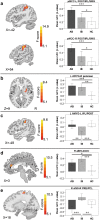Altered Central Autonomic Network in Baseball Players: A Resting-state fMRI Study
- PMID: 30643162
- PMCID: PMC6331574
- DOI: 10.1038/s41598-018-36329-9
Altered Central Autonomic Network in Baseball Players: A Resting-state fMRI Study
Abstract
The physiological adaptive regulation of healthy population with a high fitness level is associated with enhanced cognitive control in brain. This study further investigated the effects of different levels of sporting experience on intrinsic brain networks involved in central autonomic processing using resting-state functional magnetic resonance imaging. We explored functional connectivity of four core regions within central autonomic network (CAN), namely posterior midcingulate cortex (pMCC), left amygdala (AMYG), and right anterior (aINS) and left posterior insular cortices, in advanced and intermediate baseball players, and compared their strength of connectivity with individuals without baseball-playing experience. Functional connectivity maps across three groups confirmed a close relationship between CAN and large-scale brain networks in sensory, motor and cognitive domains. Crucially, both advanced and intermediate batters demonstrated enhanced connectivity between pMCC and sensorimotor network, between right aINS and dorsal anterior cingulate cortex, and between left AMYG and right putamen, than controls. These results reflected a stronger interregional coupling in sensorimotor and cognitive control, and in motor skill consolidation. In conclusion, we provided evidence that different levels of sporting experience could reorganize/enhance intrinsic functional connectivity for central autonomic processing.
Conflict of interest statement
The authors declare no competing interests.
Figures


Similar articles
-
Two systems of resting state connectivity between the insula and cingulate cortex.Hum Brain Mapp. 2009 Sep;30(9):2731-45. doi: 10.1002/hbm.20705. Hum Brain Mapp. 2009. PMID: 19072897 Free PMC article.
-
Functional segregation of the human cingulate cortex is confirmed by functional connectivity based neuroanatomical parcellation.Neuroimage. 2011 Feb 14;54(4):2571-81. doi: 10.1016/j.neuroimage.2010.11.018. Epub 2010 Nov 10. Neuroimage. 2011. PMID: 21073967
-
Gender- and Age-Specific Differences in Resting-State Functional Connectivity of the Central Autonomic Network in Adulthood.Front Hum Neurosci. 2019 Oct 17;13:369. doi: 10.3389/fnhum.2019.00369. eCollection 2019. Front Hum Neurosci. 2019. PMID: 31680919 Free PMC article.
-
Network convergence zones in the anterior midcingulate cortex.Handb Clin Neurol. 2019;166:103-111. doi: 10.1016/B978-0-444-64196-0.00007-8. Handb Clin Neurol. 2019. PMID: 31731907 Review.
-
Conjoint activity of anterior insular and anterior cingulate cortex: awareness and response.Brain Struct Funct. 2010 Jun;214(5-6):535-49. doi: 10.1007/s00429-010-0265-x. Epub 2010 May 29. Brain Struct Funct. 2010. PMID: 20512367 Free PMC article. Review.
Cited by
-
Rapid Assessment of Blood Pressure Variability and Outcome After Successful Thrombectomy.Stroke. 2021 Aug;52(9):e531-e535. doi: 10.1161/STROKEAHA.121.034291. Epub 2021 Jul 27. Stroke. 2021. PMID: 34311565 Free PMC article.
-
Neural correlates of basketball proficiency: An MRI study across skill levels.J Exerc Sci Fit. 2025 Jan;23(1):14-20. doi: 10.1016/j.jesf.2024.12.001. Epub 2024 Dec 6. J Exerc Sci Fit. 2025. PMID: 39737438 Free PMC article.
-
A systematic review and coordinate-based meta-analysis of resting-state fMRI in athletes from open and closed skills sports.Sci Rep. 2025 Jul 1;15(1):21870. doi: 10.1038/s41598-025-07192-2. Sci Rep. 2025. PMID: 40596321 Free PMC article.
-
Altered dynamics of functional connectivity density associated with early and advanced stages of motor training in tennis and table tennis athletes.Brain Imaging Behav. 2021 Jun;15(3):1323-1334. doi: 10.1007/s11682-020-00331-5. Brain Imaging Behav. 2021. PMID: 32748323
-
Neural efficiency and proficiency adaptation of effective connectivity corresponding to early and advanced skill levels in athletes of racket sports.Hum Brain Mapp. 2023 Feb 1;44(2):388-402. doi: 10.1002/hbm.26057. Epub 2022 Sep 2. Hum Brain Mapp. 2023. PMID: 36053219 Free PMC article.
References
-
- Jänig, W. Integrative action of the autonomic nervous system: Neurobiology of homeostasis. (Cambridge University Press, 2008).
Publication types
MeSH terms
Grants and funding
- MOST 104-2420-H-004-005-MY3/Ministry of Science and Technology, Taiwan (Ministry of Science and Technology of Taiwan)/International
- MOST 104-2420-H-004-005-MY3/Ministry of Science and Technology, Taiwan (Ministry of Science and Technology of Taiwan)/International
- MOST 104-2420-H-004-005-MY3/Ministry of Science and Technology, Taiwan (Ministry of Science and Technology of Taiwan)/International
- MOST 104-2314-B-010-004/Ministry of Science and Technology, Taiwan (Ministry of Science and Technology of Taiwan)/International
- MOST 104-2420-H-004-005-MY3/Ministry of Science and Technology, Taiwan (Ministry of Science and Technology of Taiwan)/International
LinkOut - more resources
Full Text Sources

